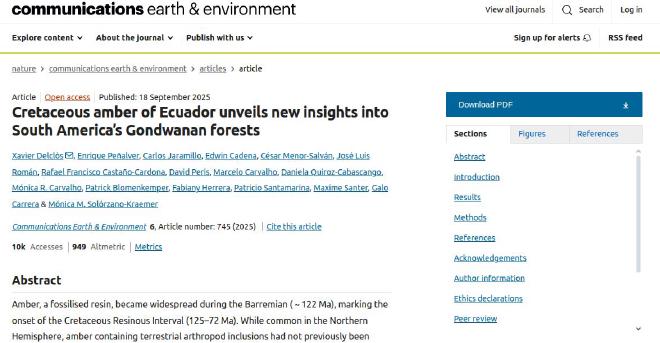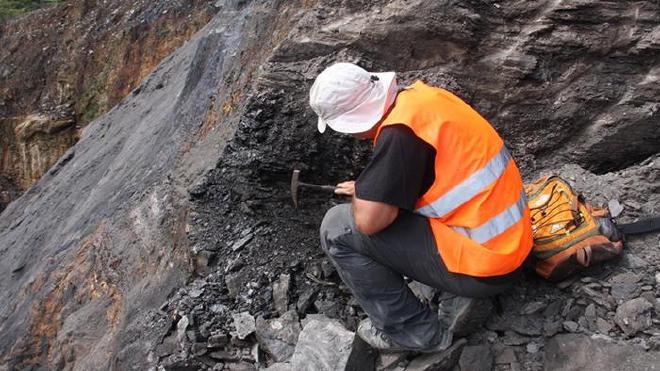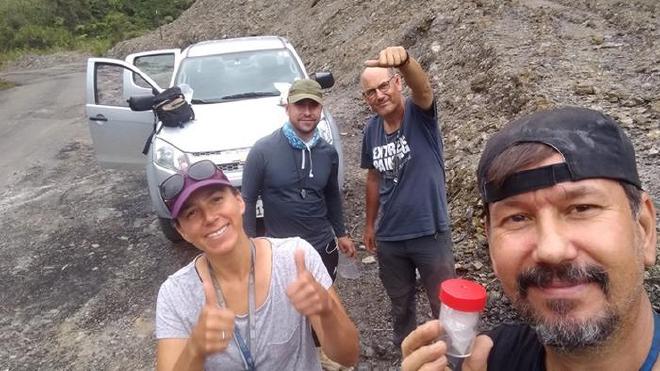

The discovery, published in the journal Communications Earth & Environment, reveals that 112 million years ago there was a tropical rainforest with ferns, cycads and angiosperm plants, and describes a unique scenario for understanding the rich biodiversity and Cretaceous ecosystems in the southern hemisphere, little studied so far in the fossil amber record.


The amber comes from a fluvial-lacustrine environment at the Genoveva quarry site (in the Tena region of the Amazon region). The resin-producing trees were probably araucariaceous conifers, according to geochemical and palynological analyses. “Everything indicates that the ancient ecosystem was wooded, humid and diverse, and has the oldest known association of angiosperm leaves in north-western South America,” said Delclòs, a member of the UB’s Department of Earth and Ocean Dynamics.

Teams from the Spanish Geological and Miner Institute National Center (IGME-CSIC), the Smithsonian Tropical Research Institute (Panama), the University of Rosario (Colombia), the Escuela Politécnica Nacional (Ecuador) and the Senckenberg Natural History Museum Frankfurt (Germany), among other institutions, have also participated in the study.
Dense, damp forest with resin-producing trees #
The study analysed 60 amber samples and identified 21 bioinclusions, with representatives of five insect orders, including Diptera (flies), Coleoptera (beetles) and Hymenoptera (ants and wasps), together with one spider web fragment. No plant remains were found within the amber, but a wide variety of plant fossils were identified in the rock samples, including spores, pollen and leaves.
The team has analysed samples of amber and surrounding rock from the Genoveva mine in Ecuador and identified two different types of amber: one formed underground around the roots of resin-producing plants (without inclusions) and another that formed when the resin was exposed in the air (with inclusions).
“Mostly chironomid and ceratopogonid dipterans were found, as well as springtails, coleoptera, hymenoptera, trichoptera, hemiptera and a fragment of a spider web. The insects point to the presence of freshwater bodies and a tropical rainforest in which the presence of rare families stands out, such as the wasps †Stigmaphronidae”, saids Enrique Peñalver, researcher at the IGME in Valencia, Spain.
Meanwhile, Carlos Jaramillo, from the Smithsonian Tropical Research Institute, said that “the pollen and macrofossils identified in the rocks that contained the amber reveal a forest with pteridophytes (ferns and related species), Araucariaceae and Cheirolepidaceae conifers, cycads and early angiosperms”, and added that “epiphytic fungi have also been detected on the fossil leaves and resinicolous fungi”.
Experts stressed that the discovery of this amber deposit is of great scientific relevance for future studies of this period. “Future excavations could help connect South American biodiversity with other regions of Gondwana, such as Antarctica, Australia and South Africa, where Cretaceous amber has also been found,” concluded Monica Solórzano Kraemer, from the Senckenberg Natural History Museum.
Citation #
- The paper Cretaceous amber of Ecuador unveils new insights into South America’s Gondwanan forests (El ámbar cretácico de Ecuador revela nuevos conocimientos sobre los bosques gondwananos de América del Sur) was published in Communications Earth & Environment journal.
Contact [Notaspampeanas](mailto: notaspampeanas@gmail.com)

